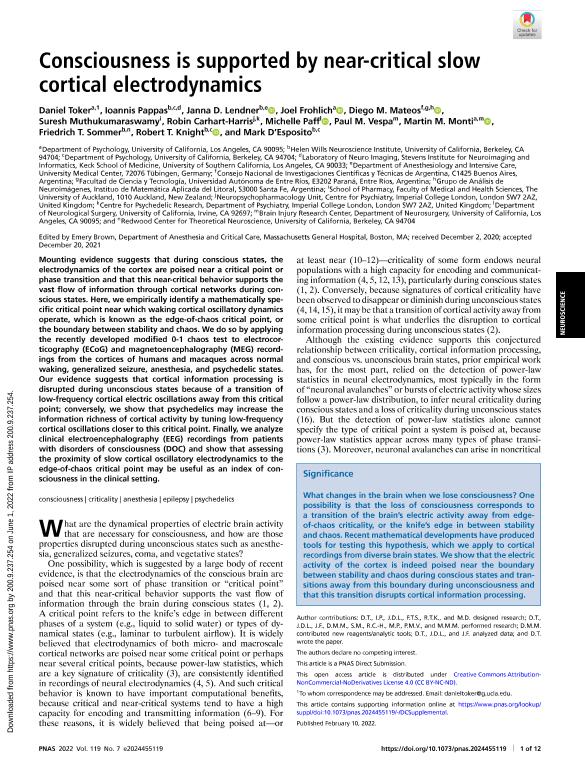Artículo
Consciousness is supported by near-critical slow cortical electrodynamics
Toker, Daniel; Pappas, Ioannis; Lendner, Janna D.; Frohlich, Joel; Mateos, Diego Martín ; Muthukumaraswamy, Suresh D.; Carhart Harris, Robin; Paff, Michelle; Vespa, Paul M.; Monti, Martin M.; Sommer, Friedrich T.; Knight, Robert T.; D’Esposito, Mark
; Muthukumaraswamy, Suresh D.; Carhart Harris, Robin; Paff, Michelle; Vespa, Paul M.; Monti, Martin M.; Sommer, Friedrich T.; Knight, Robert T.; D’Esposito, Mark
 ; Muthukumaraswamy, Suresh D.; Carhart Harris, Robin; Paff, Michelle; Vespa, Paul M.; Monti, Martin M.; Sommer, Friedrich T.; Knight, Robert T.; D’Esposito, Mark
; Muthukumaraswamy, Suresh D.; Carhart Harris, Robin; Paff, Michelle; Vespa, Paul M.; Monti, Martin M.; Sommer, Friedrich T.; Knight, Robert T.; D’Esposito, Mark
Fecha de publicación:
02/2022
Editorial:
National Academy of Sciences
Revista:
Proceedings of the National Academy of Sciences of The United States of America
ISSN:
0027-8424
Idioma:
Inglés
Tipo de recurso:
Artículo publicado
Clasificación temática:
Resumen
Mounting evidence suggests that during conscious states, the electrodynamics of the cortex are poised near a critical point or phase transition and that this near-critical behavior supports the vast flow of information through cortical networks during conscious states. Here, we empirically identify a mathematically specific critical point near which waking cortical oscillatory dynamics operate, which is known as the edge-of-chaos critical point, or the boundary between stability and chaos. We do so by applying the recently developed modified 0-1 chaos test to electrocorticography (ECoG) and magnetoencephalography (MEG) recordings from the cortices of humans and macaques across normal waking, generalized seizure, anesthesia, and psychedelic states. Our evidence suggests that cortical information processing is disrupted during unconscious states because of a transition of low-frequency cortical electric oscillations away from this critical point; conversely, we show that psychedelics may increase the information richness of cortical activity by tuning low-frequency cortical oscillations closer to this critical point. Finally, we analyze clinical electroencephalography (EEG) recordings from patients with disorders of consciousness (DOC) and show that assessing the proximity of slow cortical oscillatory electrodynamics to the edge-of-chaos critical point may be useful as an index of consciousness in the clinical setting.
Palabras clave:
ANESTHESIA
,
CONSCIOUSNESS
,
CRITICALITY
,
EPILEPSY
,
PSYCHEDELICS
Archivos asociados
Licencia
Identificadores
Colecciones
Articulos(SEDE CENTRAL)
Articulos de SEDE CENTRAL
Articulos de SEDE CENTRAL
Citación
Toker, Daniel; Pappas, Ioannis; Lendner, Janna D.; Frohlich, Joel; Mateos, Diego Martín; et al.; Consciousness is supported by near-critical slow cortical electrodynamics; National Academy of Sciences; Proceedings of the National Academy of Sciences of The United States of America; 119; 7; 2-2022; 1-12
Compartir
Altmétricas



